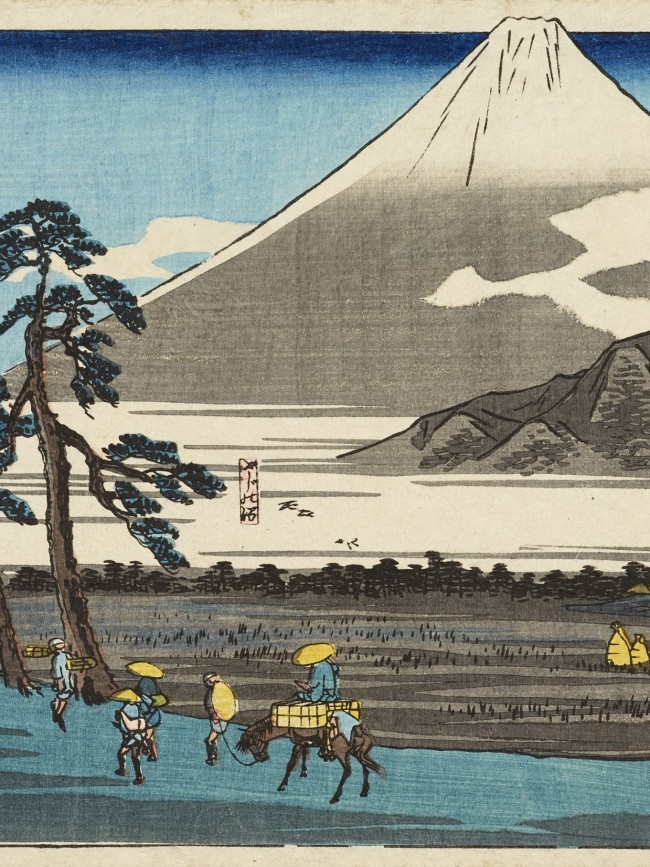Hara, 14. Station der Tōkaidō (Detail), 1850
Farbholzschnitt
Colored woodcut
18 x 23 cm
Museum für Völkerkunde Burgdorf
Foto: David Aebi, Burgdorf
Hiroshige & Kunisada
Fascinating Colour Woodcuts
05.07.2014 – 09.11.2014
In collaboration with the Museum für Völkerkunde Burgdorf, the Section for East Asian Art of the University of Zurich’s Institute of Art History (Professor Hans Bjarne Thomsen) and the Interessensverein Völkerkundesammlung Burgdorf, the Museum Franz Gertsch is exhibiting fascinating Japanese colour woodcuts in the Print Room by such artists as Hiroshige and Kunisada. The works from the collection of the Museum für Völkerkunde Burgdorf are being shown publically for the first time.
The exhibition in the Print Room consists of three complementary sections, beginning with a selection of prints from Utagawa Hiroshige’s Fifty-three Stations of the Tōkaidō (1850, Kichizo Edition), which capture Japan’s landscapes poetically and metaphorically. Utagawa Kunisada’s Fifty-three Stations of the Tōkaidō (1852) features portraits of kabuki actors in costume. The backgrounds of the prints reference Hiroshige’s works and demonstrate the smooth transition between the various genres and playful elements of the art of printing. The emergence of the Meiji period after the death of the two artists and the end of the Edo period is characterized by the opening of Japan and the growing influence of the West. The political, social and artistic changes of this time are also expressed in the contemporary colour woodcuts that conclude the exhibition and bridge the gap between feudal Japan and the dawn of a new Japan.
UTAGAWA Hiroshige (歌川広重, 1797–1858) was an artist from Edo who had a decisive influence on landscape prints (meisho-e). Inspired by illustrations in Japanese travel guides, Hiroshige produced an abundance of prints and series depicting places of interest in Japan. He likewise made diverse series of beautiful women (bijin-ga) as well as illustrations of birds and flowers (kachō-e). His most famous series include One Hundred Famous Views of Edo, Fifty-three Stations of the Tōkaidō (numerous editions) und Famous Restaurants from the Eastern Capital. Hiroshige also produced surimono (privately commissioned prints for greeting cards) and collaborated with other artists, for example with Kunisada.
UTAGAWA Kunisada (歌川国貞, 1786–1865) was an artist from Edo best known for his portraits of beautiful women (bijin-ga) and kabuki actors (yakusha-e). Regarded as the most popular artist of his day, he produced a remarkable number of illustrations. The wide-ranging repertory of this industrious artist encompasses sumō pictures (sumō-e), illustrations for Genji Monogatari (The Tale of Genji) as well as surimono and erotica (shunga). One of his best known series, which appeared in diverse editions, is Fifty-three Stations of the Tōkaidō depicting portraits of celebrated kabuki actors.
This exhibition is the first of three shows with objects from the collection of the Museum für Völkerkunde Burgdorf that mark the 150th anniversary of the opening of diplomatic relations between Japan and Switzerland in 2014. The second exhibition, “Entdeckerlust—Burgdorfer in Ostasien,” will open on October 16, 2014 in Burgdorf Castle. The final show entitled “Collecting Japan – nihon o yobiyoseru” will open on November 21, 2014 in the Cultural Center of the Japanese Embassy (JICC) in Bern.
The exhibition was curated by Marie-Anne Pinheiro and Rebeca Gomez Morilla.
An eBook is being planned that is expected to be available in the summer/fall 2015.
The exhibition in the Print Room consists of three complementary sections, beginning with a selection of prints from Utagawa Hiroshige’s Fifty-three Stations of the Tōkaidō (1850, Kichizo Edition), which capture Japan’s landscapes poetically and metaphorically. Utagawa Kunisada’s Fifty-three Stations of the Tōkaidō (1852) features portraits of kabuki actors in costume. The backgrounds of the prints reference Hiroshige’s works and demonstrate the smooth transition between the various genres and playful elements of the art of printing. The emergence of the Meiji period after the death of the two artists and the end of the Edo period is characterized by the opening of Japan and the growing influence of the West. The political, social and artistic changes of this time are also expressed in the contemporary colour woodcuts that conclude the exhibition and bridge the gap between feudal Japan and the dawn of a new Japan.
UTAGAWA Hiroshige (歌川広重, 1797–1858) was an artist from Edo who had a decisive influence on landscape prints (meisho-e). Inspired by illustrations in Japanese travel guides, Hiroshige produced an abundance of prints and series depicting places of interest in Japan. He likewise made diverse series of beautiful women (bijin-ga) as well as illustrations of birds and flowers (kachō-e). His most famous series include One Hundred Famous Views of Edo, Fifty-three Stations of the Tōkaidō (numerous editions) und Famous Restaurants from the Eastern Capital. Hiroshige also produced surimono (privately commissioned prints for greeting cards) and collaborated with other artists, for example with Kunisada.
UTAGAWA Kunisada (歌川国貞, 1786–1865) was an artist from Edo best known for his portraits of beautiful women (bijin-ga) and kabuki actors (yakusha-e). Regarded as the most popular artist of his day, he produced a remarkable number of illustrations. The wide-ranging repertory of this industrious artist encompasses sumō pictures (sumō-e), illustrations for Genji Monogatari (The Tale of Genji) as well as surimono and erotica (shunga). One of his best known series, which appeared in diverse editions, is Fifty-three Stations of the Tōkaidō depicting portraits of celebrated kabuki actors.
This exhibition is the first of three shows with objects from the collection of the Museum für Völkerkunde Burgdorf that mark the 150th anniversary of the opening of diplomatic relations between Japan and Switzerland in 2014. The second exhibition, “Entdeckerlust—Burgdorfer in Ostasien,” will open on October 16, 2014 in Burgdorf Castle. The final show entitled “Collecting Japan – nihon o yobiyoseru” will open on November 21, 2014 in the Cultural Center of the Japanese Embassy (JICC) in Bern.
The exhibition was curated by Marie-Anne Pinheiro and Rebeca Gomez Morilla.
An eBook is being planned that is expected to be available in the summer/fall 2015.

